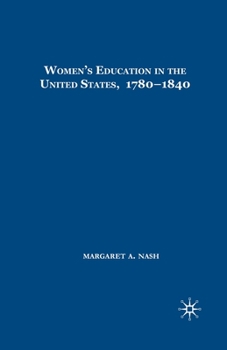Women's Education in the United States, 1780-1840
Select Format
Select Condition 
Book Overview
Please note this is a 'Palgrave to Order' title. Stock of this book requires shipment from overseas. It will be delivered to you within 12 weeks. Winner of 2005 American Educational Studies Association (AESA) Critic's Choice Award, this is a groundbreaking from Margaret Nash examining the development of women's education.
Format:Paperback
Language:English
ISBN:1403969388
ISBN13:9781403969385
Release Date:September 2007
Publisher:Palgrave MacMillan
Length:203 Pages
Weight:0.62 lbs.
Dimensions:0.5" x 5.7" x 8.2"
Customer Reviews
3 ratings
insightful introduction to antebellum women's seminaries
Published by Thriftbooks.com User , 16 years ago
This is a great little book, its 116 pages packed with intriguing detail. Nash seeks to understand the women's seminaries of the early republic and antebellum era on their own terms, not as precursors to the women's colleges of the late 19th century. She argues persuasively that women's seminaries, although they did not bill themselves as "colleges," offered a broad liberal arts education that was not only as rigorous as that offered by men's academies and colleges but also remarkably similar in content. Nash further argues that educators justified women's secondary schooling not only on the grounds that it would prepare them for wifehood and motherhood, but also on the grounds that it would promote intellectual and spiritual self-development and, potentially, prepare women to support themselves. The expansion of women's secondary education coincided with a movement to professionalize teaching, and women soon became prominent in this formerly male-dominated profession. Nash is conscious that, for the most part, only middle-class, white women enjoyed the educational opportunities that she describes. Indeed, she argues that "The most salient difference in educational opportunities [in 1780-1840] was that of class and race, not gender" (99). One chapter of the book explores the role that women's seminaries played in shaping middle-class identity, while another examines the limitations of women's seminaries, including their failure (in spite of some work-study programs) to serve many working-class students. Any work on secondary education in the nineteenth century will inevitably focus on the more affluent classes, and Nash handles this bias sensitively. A more significant limitation, to my mind, is Nash's exclusive focus only on formal education. If you are seeking a broader perspective on women's intellectual life in the early nineteenth-century United States, I would recommend Mary Kelley's Learning to Stand and Speak: Women, Education, and Public Life in America's Republic (2006). Nash's and Kelley's findings complement each other, and the two books might fruitfully be read in tandem.
Novel new scholarship, but includes only upper-middle class white women
Published by Thriftbooks.com User , 16 years ago
This work is a fairly comprehensive treatment of educational institutions in the US in the early national and antebellum period. Nash argues that during this period, opportunities for (white, middle-upper class women) increased dramatically, but that this increase did not correlate to improved opportunities for women in other arenas (i.e., political, economic power). Support for women's education came from many angles: the Lockians of the Enlightenment believed women's minds were tabula rasa, as men's, and that they had as much potential; evangelicals called to educated women to moralize communities, to promote true Christian charity (esp. through educating the young--not coincidentally, feminization of education occurred during this period in the North); republican ideals further called on women to be educated, as did social utility arguments (i.e., women's skills could help their husbands in business, educate sons, etc). Nash describes the rise of pedagogical interest during this period; colonial days had been characterized by rote memorization and lectures, while the new era called upon the development of the 'rational mind' through encouraging students to be active learners. Also, Nash connects the rise of educational opportunities to the forming identity of the new middling class (forming around the 1820s and 30s) and explores how the new pedagogies were particularly attentive to the development of this new class (i.e., by prizing education of the whole human: body and mind). Further, Nash suggests that if these opportunities were available at all, it was because women wanted them, because they pushed for them and demanded them: essentially it was women's love and yearning for knowledge that propelled the growth of educational institutions during this period. Limitations: since all the attention is given to formalized schooling for which documentation is available, Nash for the most part leaves out blacks and other minorities, as well as the lower classes in general.
An academic work, yet fascinating for the lay reader.
Published by Thriftbooks.com User , 19 years ago
This book ought to be in bookstores. A study such as this one, focused as it on the specific issue of women's education during a specific historical era, provides an excellent insight into what it must have been like to be living in American society at that time. The book goes into fascinating detail regarding who's who and how certain powerful and not-so-powerful women influenced women's education and thus American attitudes in the post-Civil War, industrial-growth era. For me as a non-educator (I run a small business), the notes don't get in the way at all, and in fact I found myself interested enough to look up many of the additional comments in the notes. Nicely done. Highly recommended.






